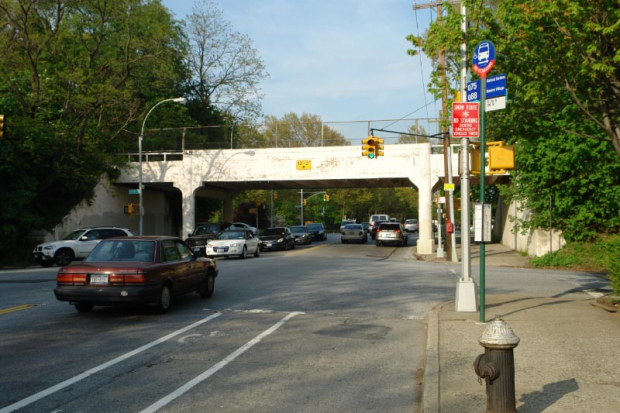Long Island Motor Parkway Bridge Series: #2 73rd Avenue Bridge in Fresh Meadows, Queens

A total of 60 Motor Parkway bridges were built from 1908 to 1926 ...a pioneering concept to eliminate grade crossings for an automobile road. There are four types of Motor Parkway bridges; over crossroads (parkway bridges), under crossroads (highway bridges), over railroad tracks (railroad bridge) and, as part of right-of-way agreements, to connect farmlands (farmway bridges). This series will document these bridges beginning at the Western Terminus in Fresh Meadows, Queens to the Eastern Terminus in Lake Ronkonkoma. Today's focus: The 73rd Avenue in Fresh Meadows, Queens:
Built in 1926, the second parkway bridge from the Western Terminus in Fresh Meadows, Queens, went over 73rd Avenue (named Black Stump Road in 1926. This bridge is one of only five remaining Motor Parkway bridges still standing.
1928 Motor Parkway Atlas- Fresh Meadows, Queens
The original western terminus planned in 1912 was scheduled to end at Black Stump Road (73rd Avenue). Al Velocci has informed me that when Motor Parkway began building this Queens section in the 1920s, Nassau Boulevard was the most heavily traveled public road...resulting in the change of the route.
Aerial- June 24, 1938
Looking north, taken two months after the Motor Parkway closed, shows the bridge's location relative to the Western Terminus and North Hempstead Turnpike Bridge.
A closer look reveals a temporary entrance to the Motor Parkway off 73rd Avenue. Al Velocci has confirmed that this "temporary entrance" was built by the Motor Parkway around 1927 when Nassau Boulevard was being built and paved. The entrance remained open until the Motor Parkway closed in 1938.
Aerial- July 23, 1939
This is one of my favorite aerials of the Motor Parkway in Queens. Looking west, the 73rd Avenue Bridge can be seen under the top arrow with the World's Fair was in the right corner.
Trylon and Perisphere of the 1939-1940 World's Fair in Flushing Meadows-Corona Park.
Aerial- 1941
This 1941 aerial shows the bridge and the newly built Francis Lewis Boulevard.
From the Ron Ridolph Collection-1981
In the 1980s, the bridge was desecrated with graffiti
Current Views
The three remaining Motor Parkway bridges in Queens have cleaned and restored. They continue to be enjoyed by pedestrians and cyclists as part of the Brooklyn-Queens Greenway. The NYC Parks website notes:
Only a few of the parkway’s original 65 bridges and underpasses survive. In 1998, then Mayor Giuliani approved $1,072,000 in funds for the reconstruction of the overpasses at 73rd Avenue, Hollis Hills Terrace, Francis Lewis Boulevard, Bell Boulevard and Springfield Boulevard, all of which Parks continues to maintain. The bridges and the road itself reflect the state of the art roadway technology of the early 20th century, when the parkway was built and modernized. Some of the original roadway material was a patented form of reinforced concrete. In years prior, road building used different methods and materials, ranging from ‘corduroy’ (log) roads to wood planks, and from oyster shells to plain dirt and oiled dirt surfaces. Parks later repaved the roadway with additional asphalt, but portions of the original concrete and asphalt surfaces, together with markers and fence posts, can be seen as one walks along the route.
In 1986, Parks rehabilitated this section of the parkway through Alley Pond and Cunningham Park. It was then incorporated into the NYC Greenway program in 1993 as part of the Brooklyn-Queens Greenway. The Greenway Program, a collaborative effort of the Department of Transportation, the City Planning Office, and Parks, is one of the most ambitious networks of landscaped paths in the nation.
In 2002, due to the efforts of the Friends of Cunningham Park, the parkland section of the Long Island Motor Parkway located in present day Cunningham and Alley Pond Parks in eastern Queens was placed on the New York State and National Registers of Historic Places. This section amounts to approximately 2.5 miles of roadway. While efforts are underway for preservation of other sections of the historic Motor Parkway, this section of the parkway that falls under Parks’ jurisdiction is the largest preservation effort of this type for the Motor Parkway.
The overgrowth alongside the road has resulted in a canopy of trees over much of the length of the parkway, making the parkway true to its name – as much a park as a right-of-way, and a truly green progenitor to the current parkway system.
Links to related posts on VanderbiltCupRaces.com and the Internet:
Google Map of Fresh Meadows, Queens
Archives: Long Island Bridge Series
Archives: Long Island Bridge Series
Archives: Long Island Motor Parkway- The Western Terminus in Fresh Meadows, Queens
The Long Island Motor Parkway Survey Atlas: Fresh Meadows- The Western Terminus
Brooklyn-Queens Greenway Guide
The Planned Fresh Meadows Motor Parkway Western Terminus in 1912
Archives: Long Island Motor Parkway Bridges- Queens
Archives: Long Island Motor Parkway- Bridges











Comments
The aerial of the “new” Francis Lewis Blvd. can’t be from 1941. Although the extension of the Blvd (I remember the original 3-lane in each direction concrete road) had been built, it wasn’t opened until one year after the War when lampposts for lighting were installed.
The shot looking west is beautiful. The main road towards the left is Union Tpke., which had been extended from Homelawn Street/Utopia Pkwy, as part of a WPA project. In this regard, a portion of the Hillcrest Country Club Golf course can be seen at the southwest corner of the intersection. land was eventually sold to St. John’s, which built its University there during the 50s and 60s, except for big gray building on a rise in the middle of the tract. In the early 50s my mother and I would change buses from the Q17 to the Q17a at the intersection; the Q17 cut west on Horace Harding, while the Q17a cut east, which then took us to Francis Lewis Blvd, four blocks from our house.